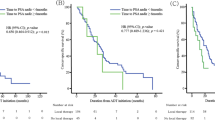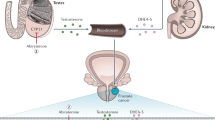Abstract
Objective: Tumour features were evaluated during intermittent androgen suppression (IAS), and their prognostic impact on the first off-treatment time was analysed.
Patients and methods: Twenty patients with advanced prostate cancer underwent three consecutive prostate biopsies during the first cycle, namely at the beginning of androgen deprivation, 8 months after continuous therapy and at the time of prostate-specific antigen (PSA) progression above 20 ng/ml. Biopsy specimens were immunohistochemically processed and analysed for the apoptotic index (AI), Ki-67, p53 and Bcl-2 to investigate eventual changes over time. Correlations and regression analysis were performed to assess the prognostic significance of clinical and pathological parameters in predicting the first off-treatment time.
Results: In contrast to the AI, p53 and Bcl-2, Ki-67 was the only marker that significantly changed over time (P=0.008). The first off-treatment time correlated significantly with pretreatment PSA (r=−0.594; P<0.01), testosterone recovery time (r=0.590; P=0.013) and biopsy grade (r=−0.738; P<0.01); only the latter gaining an independent factor in the multivariate analysis (P=0.022).
Conclusions: During IAS, Ki-67 was the only molecular marker that consistently changed over time. However, it did not correlate with off-treatment time that was predicted independently by the initial biopsy grade only. First off-treatment time was best predicted by clinical parameters and molecular markers from needle biopsies did not further contribute to a better patient selection.
This is a preview of subscription content, access via your institution
Access options
Subscribe to this journal
Receive 4 print issues and online access
$259.00 per year
only $64.75 per issue
Buy this article
- Purchase on Springer Link
- Instant access to full article PDF
Prices may be subject to local taxes which are calculated during checkout

Similar content being viewed by others
References
Huggins C, Hodges C . Studies of prostatic cancer: I. Effect of castration, estrogen and androgen injections on serum phosphatase in metastatic carcinoma of the prostate. Cancer Res 1941; 1: 293–297.
Higano C, Shields A, Wood N, Brown J, Tangen C . Bone mineral density in patients with prostate cancer without bone metastases treated with intermittent androgen suppression. Urology 2004; 64: 1182–1186.
Fossa SD, Woehre H, Kurth KH, Hetherington J, Bakke H, Rustad DA et al. Influence of urological morbidity on quality of life in patients with prostate cancer. Eur Urol 1997; 31 (Suppl 3): 3–8.
Goldenberg SL, Bruchovsky N, Gleave ME, Sullivan LD, Akakura K . Intermittent androgen suppression in the treatment of prostate cancer: a preliminary report. Urology 1995; 45: 839–844.
De La Taille A, Zerbib M, Conquy S, Amsellem-Ouazana D, Thiounn N, Flam TA et al. Intermittent androgen suppression in patients with prostate cancer. BJU Int 2003; 91: 18–22.
Akakura K, Bruchovsky N, Goldenberg SL, Rennie PS, Buckley AR, Sullivan LD . Effects of intermittent androgen suppression on androgen-dependent tumours. Apoptosis and serum prostate-specific antigen. Cancer 1993; 71: 2782–2790.
Sato N, Gleave ME, Bruchovsky N, Rennie PS, Goldenberg SL, Lange PH et al. Intermittent androgen suppression delays progression to androgen-independent regulation of prostate-specific antigen gene in the LNCaP prostate tumour model. J Steroid Biochem Mol Biol 1996; 58: 139–146.
Oken MM, Creech RH, Tormey DC, Horton J, Davis TE, McFadden ET et al. Toxicity and response criteria of the Eastern Cooperative Oncology Group. Am J Clin Oncol 1982; 5: 649–655.
Mostofi FK . Grading of prostatic carcinoma. Cancer Chemother Rep 1975; 59: 111–117.
Sato N, Akakura K, Isaka S, Nakatsu H, Tanaka M, Ito H et al. Intermittent androgen suppression for locally advanced and metastatic prostate cancer: preliminary report of a prospective multicenter study. Urology 2004; 64: 341–345.
Sato N, Gleave ME, Bruchovsky N, Rennie PS, Beraldi E, Sullivan LD . A metastatic and androgen-sensitive human prostate cancer model using intraprostatic inoculation of LNCaP cells in SCID mice. Cancer Res 1997; 57: 1584–1589.
Crook JM, Szumacher E, Malone S, Huan S, Segal R . Intermittent androgen suppression in the management of prostate cancer. Urology 1999; 53: 530–534.
Grossfeld GD, Chaudhary UB, Reese DM, Carroll PR, Small EJ . Intermittent androgen deprivation: update of cycling characteristics in patients without clinically apparent metastatic prostate cancer. Urology 2001; 58: 240–245.
Albrecht W, Collette L, Fava C, Kariakine OB, Whelan P, Studer UE et al. Intermittent maximal androgen blockade in patients with metastatic prostate cancer: an EORTC feasibility study. Eur Urol 2003; 44: 505–511.
Prapotnich D, Fizazi K, Escudier B, Mombet A, Cathala N, Vallancien G . A 10-year clinical experience with intermittent hormonal therapy for prostate cancer. Eur Urol 2003; 43: 233–239.
Koivisto P, Visakorpi T, Rantala I, Isola J . Increased cell proliferation activity and decreased cell death are associated with the emergence of hormone-refractory recurrent prostate cancer. J Pathol 1997; 183: 51–56.
Paterson RF, Gleave ME, Jones EC, Zubovits JT, Goldenberg SL, Sullivan LD . Immunohistochemical analysis of radical prostatectomy specimens after 8 months of neoadjuvant hormonal therapy. Mol Urol 1999; 3: 277–286.
Matsushima H, Goto T, Hosaka Y, Kitamura T, Kawabe K . Correlation between proliferation, apoptosis, and angiogenesis in prostate carcinoma and their relation to androgen ablation. Cancer 1999; 85: 1822–1827.
Miyata Y, Kanda S, Sakai H, Hakariya T, Kanetake H . Relationship between changes in prostate cancer cell proliferation, apoptotic index, and expression of apoptosis-related proteins by neoadjuvant hormonal therapy and duration of such treatment. Urology 2005; 65: 1238–1243.
Lu Q-L, Abel P, Foster CS, Lalani E-M . Bcl-2: role in epithelial differentiation and oncogenesis. Hum Pathol 1996; 27: 102–110.
Colombel M, Symmans F, Gil S, O'Toole KM, Chopin D, Benson M et al. Detection of the apoptosis-suppressing oncoprotein bc1-2 in hormone-refractory human prostate cancers. Am J Pathol 1993; 143: 390–400.
Raffo AJ, Perlman H, Chen MW, Day ML, Streitman JS, Buttyan R . Overexpression of Bcl-2 protects prostate cancer cells from apoptosis in vitro and confers resistance to androgen depletion in vivo. Cancer Res 1995; 55: 4438–4445.
Finlay CA, Hinds PW, Levine AJ . The p53 proto-oncogene can act as a suppressor of transformation. Cell 1989; 57: 1083–1093.
Grossfeld GD, Olumi AF, Connolly JA, Chew K, Gibney J, Bhargava V et al. Locally recurrent prostate tumors following either radiation therapy or radical prostatectomy have changes in KI-67 labeling index, p53 and bcl-2 immunoreactivity. J Urol 1998; 159: 1437–1443.
Stapleton AM, Zbell P, Kattan MW, Yang G, Wheeler TM, Scardino PT et al. Assessment of the biological markers p53, Ki-67, and apoptotic index as predictive indicators of prostate carcinoma recurrence after surgery. Cancer 1998; 82: 168–175.
Lewis JS, Vollmer RT, Humphrey PA . Carcinoma extent in prostate needle biopsy tissue in the prediction of whole gland tumor volume in a screening population. Am J Clin Pathol 2002; 118: 442–450.
Klotz L, Correia A, Zhang W . The relationship between the androgen receptor CAG repeat polymorphism length and the response to intermittent androgen suppression therapy for advanced prostate cancer. Prostate Cancer Prostatic Dis 2005; 8: 179–183.
Pether M, Goldenberg SL . Intermittent androgen suppression. BJU Int 2004; 93: 258–261.
Acknowledgements
This work was supported by a grant from Astra Zeneca GmbH, Vienna, Austria.
Author information
Authors and Affiliations
Corresponding author
Rights and permissions
About this article
Cite this article
Augustin, H., Freibauer, C., Bayer, L. et al. Molecular markers and their prognostic impact in patients with advanced prostate cancer undergoing intermittent androgen suppression. Prostate Cancer Prostatic Dis 9, 279–283 (2006). https://doi.org/10.1038/sj.pcan.4500883
Received:
Accepted:
Published:
Issue Date:
DOI: https://doi.org/10.1038/sj.pcan.4500883
Keywords
This article is cited by
-
Effect of intermittent androgen blockade on the quality of life of patients with advanced prostate carcinoma
Chinese Journal of Clinical Oncology (2007)



